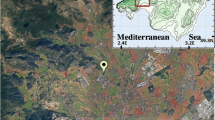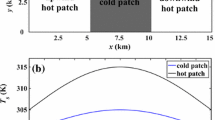Summary
Land-surface heterogeneity affects surface energy fluxes. The magnitudes of selected land-surface influences are quantified by comparing observations with model simulations of the FIFE (First ISLSCP Field Experiment) domain. Several plausible heterogeneous and homogeneous initial and boundary conditions are examined, although soilmoisture variability is emphasized. It turns out that simple spatial averages of surface variation produced biased flux values. Simulated maximum latent-heat fluxes were approximately 30 to 40 W m−2 higher, and air temperatures ≃ 0.4 °C lower (at noon), when computations were initialized with spatially averaged soil-moisture and leaf-area-index fields. The planetary boundary layer (PBL) height and turbulent exchanges were lower as well. It additionally was observed that (largely due to the nonlinear relationship between initial soil-moisture availability and the evapotranspiration rate), “real” latent-heat flux can be substantially less than simulated latent-heat flux using models initialized with spatially averaged soil-moisture fields. Differences between “real” and simulated fluxes also vary with the resolution at which “real” soil-moisture heterogeneity is discretized.
Similar content being viewed by others
References
Avissar, R., Pielke, R. A., 1989: A parameterization of heterogeneous land surfaces for atmospheric numerical model and its impact on regional meteorology.Mon. Wea. Rev. 117, 2113–2136.
Avissar, R., Pielke, R. A., 1991: The impact of plant stomatal control on mesoscale atmospheric circulations.Agric. Forest Meteor. 54, 353–372.
Boer, G. J., Appe, K., Blackburn, M., Déqué, M., Gates, W. L., Hart, T. L., le Treut, H., Roeckner, E., Sheinin, D. A., Simmonds, I., Smith, R. N. B., Tokioka, T., Wetherald, R. T., Williamson, D., 1992: Some results from an intercomparison of the climates simulated by 14 atmospheric general circulation models.J. Geophys. Res. 97, (D12), 12771–12786.
Deardorff, J. W., 1974: A three-dimensional numerical study of turbulence in an entraining mixed layer.Bound.- Layer Meteor. 7, 199–226.
Deardorff, J. W., 1978: Efficient prediction of ground surface temperature and moisture, with inclusion of a layer of vegetation.J. Geophys. Res. 83, 1889–1903.
Dickinson, R. E., 1992: Land surface. In: Trenberth, K. E. (ed.)Climate System Modeling. Cambridge: Cambridge University Press, Chapter 5, pp. 149–172.
Garratt, J. R., 1993: Sensitivity of climate simulations to land-surface and atmospheric boundary-layer treatments — a review.J. Climate 6, 419–449.
Klink, K., Willmott, C. J., 1994: Influence of soil moisture and surface roughness heterogeneity on modeled climate.Climate Res. 4, 105–118.
Mahrer, Y., Pielke, R. A., 1977: A numerical study of the airflow over irregular terrain.Contrib. Atmos. Phys. 50, 98–113.
Mahrer, Y., Pielke, R. A., 1978: A test of an upstream spline interpolation technique for the advective terms in a numerical mesoscale model.Mon. Wea. Rev. 106, 818–830.
Manabe, S., 1969: Climate and the ocean circulation: I. The atmospheric circulation and the hydrology of the earth's surface.Mon. Wea. Rev. 97, 739–774.
McCumber, M. C., Pielke, R. A., 1981: Simulation of the effects of surface fluxes of heat and moisture in a mesoscale numerical model. Part I: Soil layer.J. Geophys. Res. 86, 9929–9938.
McNider, R. T., Pielke, R. A., 1981: Diurnal boundary-layer development over sloping terrain.J. Atmos. Sci. 38, 2198–2212.
Oglesby, J. R., 1991: Spring soil moisture, natural climatic variability, and North American drought as simulated by the NCAR Community Climate Model 1.J. Climate 4, 890–897.
Oke, T. R., 1987:Boundary Layer Climates. New York: Routledge.
Physick, W. L., 1988: Mesoscale modeling of a cold front and its interaction with a diurnally heated land mass.J. Atmos. Sci. 45, 3169–3187.
Pielke, R. A., 1974: A three-dimensional numerical model of the sea breezes over South Florida.Mon. Wea. Rev. 102, 115–139.
Pielke, R. A., Mahrer, Y., 1975: Representation of the heated planetary boundary layer in mesoscale models with coarse vertical resolution.J. Atmos. Sci. 32, 2288–2308.
Pielke, R. A., 1984:Mesoscale Meteorological Modeling. Orlando: Academic Press.
Pielke, R. A., Dalu, G. A., Snook, J. S., Lee, T. J., Kittel, T. G. F., 1991: Nonlinear influence of mesoscale land use on weather and climate.J. Climate 4, 1053–1069.
Pitman, A. J., Yang, Z. L., Henderson-Sellers, A., 1993: Subgrid scale precipitation in AGCMs: re-assessing the land surface sensitivity using a single column model.Climate Dynamics 9, 33–41.
Segal, M., Mahrer, Y., Pielke, R. A., 1982: Application of a numerical mesoscale model for the evaluation of seasonal persistent regional climatological patterns.J. Appl. Meteor. 21, 1754–1762.
Sellers, P. J., Hall, F. G., Asrar, G., Strebel, D. E., Murphy, R. E., 1988: The First ISLSCP Field Experiment (FIFE).Bull. Amer. Meteor. Soc. 69, 22–27.
Sellers, P. J., Hall, F. G., Asrar, G., Strebel, D. E., Murphy, R. E., 1992: An overview of the First International Satellite Land Surface Climatology Project (ISLSCP) Field Experiment (FIFE).J. Geophys. Res. 97, 18345–18371.
Shepard, D., 1968: A two-dimensional interpolation function for irregularly spaced data. Proceedings of 23rd National Conference, ACM, 517–524.
Song, J., 1995: Influence of heterogeneous land surfaces on the surface energy budget at meso- and large scales. Dissertation at University of Delaware.
Song, J., Willmott, C. J., Hanson, B., 1997: Simulating the surface energy budget over the Konza Prairie with a mesoscale model.Agric. Forest Meteor. (forthcoming).
Shukla, J., Mintz, Y., 1982: Influence of land surface evapotranspiration on the earth's climate.Science 215, 1498–1501.
Steyn, D. G., McKendry, I. G., 1988: Quantitative and qualitative evaluation of a three-dimensional mesoscale numerical model simulation of a sea breeze in complex terrain.Mon. Wea. Rev. 116, 1914–1926.
Wood, E. F., Lakshmi, V., 1993: Scaling water and energy fluxes in climate systems: three land-atmospheric modeling experiments.J. Climate 6, 839–857.
Zhang, D., Anthes, R. A., 1982: A high-resolution model of the planetary boundary layer-sensitivity tests and comparisons with SESAME-79 data.J. Appl. Meteor. 21, 1594–1609.
Zeng, X., Pielke, R., 1995: Landscape-induced atmospheric flow and its parameterization in large-scale numerical models.J. Climate 8, 1156–1177.
Author information
Authors and Affiliations
Additional information
With 8 Figures
Rights and permissions
About this article
Cite this article
Song, J., Willmott, C.J. & Hanson, B. Influence of heterogeneous land surfaces on surface energy and mass fluxes. Theor Appl Climatol 58, 175–188 (1997). https://doi.org/10.1007/BF00865018
Received:
Issue Date:
DOI: https://doi.org/10.1007/BF00865018




